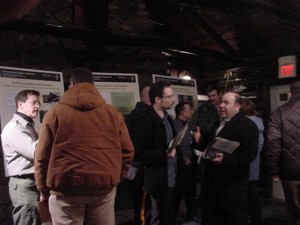NPS scoping hearings in progress
February 18th, 2010
Scene from yesterday’s NPS meeting at Camp Jefferson, Lake Hopatcong, NJ
PSEG’s Susquehanna-Roseland transmission line through the Delaware Water Gap is under scrutiny.
Just out – PSEG year end info (just searched SEC and don’t see it there yet):
And for some reason, I get that old hook line, a little perverted, i.e., “We gotta lock down our electric revenue, and then we’ll take it higher!”:
Yesterday was the second of three public comment hearings that the National Park Service is holding regarding PSEG’s application to expand the Right of Way and run its Susquehanna-Roseland through the Delaware Water Gap, a premier federally designated “wild and scenic” area. The good news is that people are really turning out, the first meeting, in Bushkill, PA, was about 100, and this meeting was twice that, standing room only in the log hall of Camp Jefferson.
Here is the NPS’ take on framework and issues for the Environmental Impact Statement:
Here’s a few snippets that I really find interesting — and of course want to expand on:
Air Quality
Construction and maintenance activities would impact air quality.Viewsheds
The new transmission lines and associated roadways would affect the visual viewshed. Viewshed impacts would be permanent. A separate viewshed analysis should be done for scenic and visual impacts. A comprehensive list of the viewsheds at DEWA does not exist at this time. However, the APPA is considered a scenic viewshed. The baseline conditions are represented by the current viewshed, which has not yet been evaluated.Climate Change/Greenhouse Gases
How the project contributes to the production of greenhouse gases and climate change, as well as how climate change would impact the project and park resources must be addressed in the EIS.Viewshed Appreciation
The new transmission lines and associated roadways could adversely affect the visitors’ appreciation of the visual viewshed. These impacts would be permanent. A separate viewshed analysis should be done for scenic and visual impacts for visitor experience.
The one that jumps out to me is “air quality.” I note that under “Climate Change/Greenhouse Gases” they acknowledge the project contribution of greenhouse gas and climate change, and that also needs to be added to the Air Quality section, the project contribution of pollutants to air quality.
Why? Check the RTEP, PJM’s 2007 RTEP that this Susquehanna-Roseland project was based on:
Critical RTEP Issues and Upgrades
PJM continues to address a number of issues with
a bearing on reliability in Pennsylvania and the
regional transmission expansion plans required to
maintain it:• Increasing power transfers through Pennsylvania to feed eastern Mid-Atlantic PJM load centers including those in Pennsylvania are expected to cause overloads beginning in 2016 on key circuits in Pennsylvania. New high voltage backbone facilities are required to mitigate these reliability issues. The new backbone facilities will also be assessed for their ability to support deliveries from a cluster of new coal-fired generating facilities currently proposed for central and northeastern Pennsylvania. Three major new backbone transmission facilities have been approved by the PJM to resolve growing reliability criteria violations in eastern Mid-Atlantic PJM and west/central Pennsylvania, upgrades that are now part of PJM’s RTEP:
• Susquehanna – Lackawanna – Jefferson – Roseland 500 kV circuit
• Amos – Bedington – Kemptown (PATH) 765 & 500 kV circuit
• Mid-Atlantic Power Pathway (MAPP): Possum Point – Calvert Cliffs – Indian River – Salem 500 kV Circuit
2007 RTEP, p.259-260 (emphasis added)
Beginning on p. 262, the RTEP lists 2,712 (check my math) of coal in queue. Yup, Susquehanna-Roseland could handle that! Here’s the full PA chapter of the 2007 RTEP — see for yourself:
The New Jersey one says essentially the same thing:
Those new coal plants and the impacts of facilitating/enabling those new coal plants and the impact on the Class I park must be addressed. The operational impacts, contributions to greenhouse gases, applies equally to air quality. This was an issue with Voyageurs National Park in the Mesaba Project review, and it should be here.
Here’s the “study area” designated by National Park Service – the “no data” spot is Picatinny Arsenal. What happens if you build transmission over an arsenal? What is the impact on the park if Picatinny Arsenal goes BOOM!?!?!
Here are some articles, thanks to Scott Olson ( Fired up and ready to go one more time! ) for compilation:
- Last stand: Critics slam power line plans across Delaware Water Gap, Appalachian Trail (Daily Record)
- Crowd of 200 puts Park Service on notice (New Jersey Herald)
- N.J. residents, environmentalists urge National Park Service to reject proposed $750M power line (Star-Ledger)
- New Jersey residents make plea to National Park Service to oppose power lines project (The Express-Times)


Leave a Reply